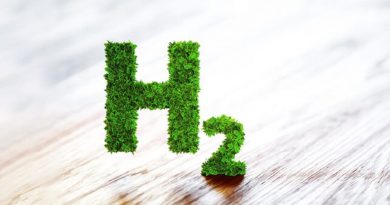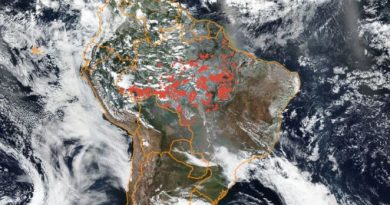Energy Revolution: A Global Outlook
This report by Imperial College, London, Drax and E4tech is a timely look at the global moves to decarbonise, coming right after the COP 24 summit.

The Year-end is the time to revisit what all was done and achieved and this is what the Global Outlook on Energy revolution report has done. We cannot emphasize enough on the need for progress towards clean energy, to limit warming to 1.5 C, and the report has looked into decarbonizing the global energy system.
The Energy Revolution Global Outlook report, compiled and written by Imperial college and E4Tech have ranked 25 Major world economies. These include all of the G7 and BRICS countries, and together they represent 80% of the global population, 77% of GDP, and 73% of carbon emissions. There are insights on:
Clean Power
Carbon Content of Electricity
The average carbon intensity of electricity worldwide has fallen only 7% in the last decade to 450 grams of CO2 per kilowatt hour (gCO2/kWh).
In 2017, the global average carbon intensity of electricity was 450 gCO2 per kWh consumed. In our league table, 16 out of 25 major countries are below this average, and 3 are below a longer-term target of 50 gCO2 /kWh.
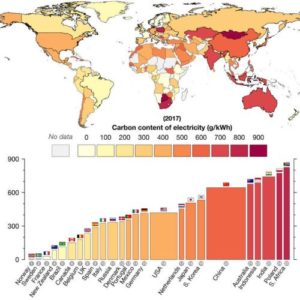
Several countries have lowered the carbon content of their electricity by 100 g/kWh over the last decade. The UK is alone in achieving more than double this pace, prompted by strong carbon pricing.
China is cleaning up its power sector faster than most of Europe, however several Asian countries are moving towards higher-carbon electricity.
Several large Asian countries – Japan, South Korea, India, Indonesia – increased their carbon intensity as they now rely more heavily on coal.
Germany has added nearly 1 kW of renewable capacity per person over the last decade. Northern Europe leads the way, followed by Japan, the US and China. In absolute terms, China has 2.5 times more renewable capacity than the US.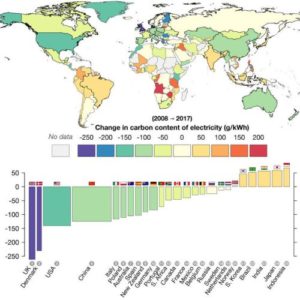
Fossil fuels
Phasing out coal power
Coal has provided around two-fifths of the world’s electricity for the last 30 years. This has barely moved over the last decade as the falling share in most OECD countries is being countered by growing electricity demand in coal-reliant Asian countries.
In 2017, our sample of major countries ranged from using coal for 0% up to almost 90% of their electricity generation. Of the six least-reliant countries, four are in Europe, and all make significant use of hydropower or nuclear for their electricity supply.
Of the six heaviest coal users, three are in Asia, joined by South Africa, Australia and Poland. All of these countries have significant indigenous coal resources, which presents complex challenges to reducing reliance on coal.
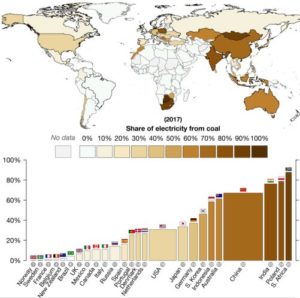
The share of coal in global electricity generation has only fallen by 2% over the last decade (2008 to 2017).
Coal reliance has declined slightly across Europe (from 26 to 22% on average). The largest national reductions have happened in the UK and Denmark.
Coal’s share in the US has fallen to 30% primarily because of market forces. The low cost of natural gas since the shale revolution has made coal uncompetitive.
However, many Asian countries are strengthening their reliance: Indonesia, India, Japan and South Korea have all seen marked increases. Of all the countries in Asia, North Korea is the unlikely climate champion for having halved its coal reliance to 20% over the last decade.
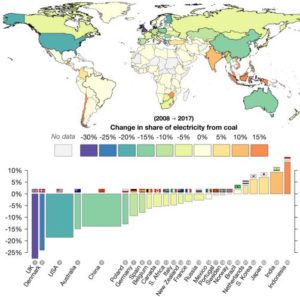
After the underwhelming COP24 Katowice Meeting in Poland, the report goes on calling names of the major economies who may or may not be faring well in their promise to keep their emissions under control. The Recent UN report has underlined that CO2 emission rose for the first time in 2017 after a three year hiatus, highlighting the imperative for countries to deliver on their promises. Total annual greenhouse gases emissions, including from land-use change, reached a record high of 53.5 Gigatons in 2017, an increase of 0.7 compared with 2016.
Also Read: Outcomes from the Katowice Climate Meet. Cloudy

